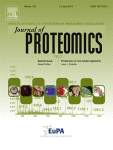Ver ítem
- xmlui.general.dspace_homeCentros Regionales y EEAsCentro Regional Santa FeEEA RafaelaArtículos científicosxmlui.ArtifactBrowser.ItemViewer.trail
- Inicio
- Centros Regionales y EEAs
- Centro Regional Santa Fe
- EEA Rafaela
- Artículos científicos
- Ver ítem
Comparative proteomics for the characterization of the most relevant Amblyomma tick species as vectors of zoonotic pathogens worldwide
Resumen
Ticks transmit zoonotic pathogens worldwide. Nevertheless, very little information is available on their genome, transcriptome and proteome. Herein, we characterized the proteome of Amblyomma americanum adults and nymphs because of their role in pathogen transmission and compared the proteome of A. americanum, A. cajennense and A. variegatum adult ticks. We also used de novo sequencing proteomics data for the analysis of the phylogenetic relationships
[ver mas...]
Ticks transmit zoonotic pathogens worldwide. Nevertheless, very little information is available on their genome, transcriptome and proteome. Herein, we characterized the proteome of Amblyomma americanum adults and nymphs because of their role in pathogen transmission and compared the proteome of A. americanum, A. cajennense and A. variegatum adult ticks. We also used de novo sequencing proteomics data for the analysis of the phylogenetic relationships between the three Amblyomma spp. in a proof of concept for phyloproteomics. The results showed that host and tick proteins involved in blood digestion, heme detoxification, development and innate immunity were differentially represented between adults and nymphs. Although these ticks were unfed, over-represented host proteins may supply nutrients during off-host periods. Tick proteins involved in tick attachment, feeding, heat shock response, protease inhibition and heme detoxification were differentially represented between Amblyomma spp., suggesting adaptation processes to biotic and abiotic factors. These results suggested that phyloproteomics might be a useful tool for the phylogenetic analysis of tick species in which sequence data is a limiting factor and demonstrate the possibilities of proteomics studies for the characterization of relevant tick vector species and provide new relevant information to understand the physiology, development and evolution of these tick species.
[Cerrar]

Autor
Villar, Margarita;
Popara, Marina;
Mangold, Atilio Jose;
Fuente, José de la;
Fuente
Journal of Proteomics 105 : 204-216 (June 2014)
Fecha
2014-06-13
ISSN
1874-3919
1876-7737
1876-7737
Formato
pdf
Tipo de documento
artículo
Palabras Claves
Derechos de acceso
Restringido
 Excepto donde se diga explicitamente, este item se publica bajo la siguiente descripción: Creative Commons Attribution-NonCommercial-ShareAlike 2.5 Unported (CC BY-NC-SA 2.5)
Excepto donde se diga explicitamente, este item se publica bajo la siguiente descripción: Creative Commons Attribution-NonCommercial-ShareAlike 2.5 Unported (CC BY-NC-SA 2.5)

